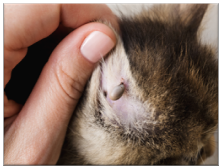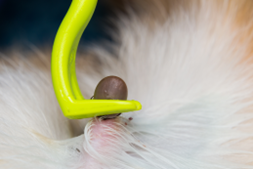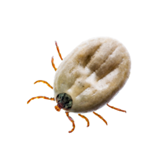The Tick List – Dr. Sophie Bell
Published: 20 July 2023
The Tick List - written by Dr. Sophie Bell
Ticks are most active during the warmer months typically April to September, but they can be discovered year-round on your pet. Regular checks of your dogs and cats are important, including inside their ears and between paw pads. Although ticks carry many diseases, Lyme disease is the biggest concern in the UK. It is a bacteria transmitted by ticks and is more likely to occur in dogs, this is rarely diagnosed in cats.
These small blood sucking creatures can strike all year round, especially in cats who like to hunt and explore and dogs walked in woodland areas or long grass, some of a tick’s favourite hideouts. Because they suck blood, if found in large numbers then there could also be a risk of anaemia in your pet.

Ticks are often very small in size, but once they feed on your pet, they can become very large as they are engorged with blood.
Sometimes a skin tag can look like a tick, but you will not see any mouth parts visible on a skin tag.
Tick be gone!
It is important to remove a tick SAFELY. Ignore the myths and old wife’s tales such as using Vaseline or alcohol or even burning them off! These are not safe or reliable.
Invest in a tick removing tool, these do not include tweezers which often pop the body and leave the head behind. There are several varieties of tick tool, a forked one is one such example.
 These often come in a pack of two, one for smaller ticks and one for larger. By applying them below the tick’s body and then twisting in any direction, you will remove the tick safely.
These often come in a pack of two, one for smaller ticks and one for larger. By applying them below the tick’s body and then twisting in any direction, you will remove the tick safely.
There are a variety of preventative tick treatments on the market for both dogs and cats. Ask your vet for some advice.
Have I removed the entire tick?

Sometimes you remove the tick’s body, but there are some mouth parts left behind, which is why it is important to check the area after removal. Also make sure to check whether the tick is intact to ensure you have not left anything behind.
If this happens do not panic – think of it like a splinter, sometimes they’ll work themselves out of the body in a day or two. If you want some extra certainty, or you can ask your vet to help remove ticks. If left for days there is a risk of an infection, again like if you had a splinter.
Why is there a lump on my pet after removal?
This is extremely common and is due to a reaction to the tick’s saliva at the site where the tick had been feeding. It is often termed a granuloma. If there is not any pus or pain it will resolve on its own over a few days. You can always clean the area with some cooled boiled water post removal and apply a cold compress if you wish.
Can there be complications?
Lyme disease has been mentioned, but in the UK the number of reported cases is low and it is extremely rare in cats. BUT you should be aware of what you may see if your pet did develop Lyme disease.
Symptom checker…
• Lethargy
• Lameness
• Stiff limbs
• Swollen joints
• Vomiting and/or diarrhoea
• Anorexia (loss of appetite)
• Fever (usually over 39.2˚C/102.5˚F)
• Enlarged lymph nodes
• Kidney failure may occur
A blood test would be required for diagnosis and treatment may include antibiotics, fluids, and pain relief. If caught early enough, treatment can stop the disease from progressing. Antibiotics maybe required for several weeks and costs can become high and could run into the thousands if there were complications.
Don’t let these blood suckers ruin your summer, but do be vigilant and prepared to twist out a tick or two. Be sure to purchase a tick remover and to check your pets daily if you can.
